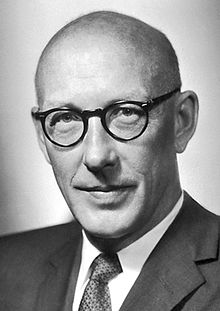Edward Tatum
Edward Tatum | |
|---|---|
 | |
| Born | Edward Lawrie Tatum December 14, 1909 Boulder, Colorado,United States |
| Died | November 5, 1975(aged 65) New York City,United States |
| Alma mater | University of Chicago University of Wisconsin–Madison |
| Known for | Generegulation of biochemical events within cells |
| Awards | Nobel Prize in Physiology or Medicine |
| Scientific career | |
| Fields | Genetics |
| Institutions | Stanford University Yale University Rockefeller Institute |
| Doctoral students | |
| Other notable students | Esther M. Lederberg |
Edward Lawrie Tatum(December 14, 1909 – November 5, 1975) was an Americangeneticist.He shared half of theNobel Prize in Physiology or Medicinein 1958 withGeorge Beadlefor showing thatgenescontrol individual steps inmetabolism.The other half of that year's award went toJoshua Lederberg.[1]Tatum was an elected member of the United StatesNational Academy of Sciences,[2]theAmerican Philosophical Society,[3]and theAmerican Academy of Arts and Sciences.[4]
Education[edit]
Edward Lawrie Tatum was born on December 14, 1909, inBoulder, Colorado[5]to Arthur L. Tatum and Mabel Webb Tatum. Arthur L. Tatum was a chemistry professor, who by 1925 was a professor of pharmacology at the University of Wisconsin at Madison.[1]
Edward Lawrie Tatum attended college at theUniversity of Chicagofor two years,[6]before transferring to theUniversity of Wisconsin–Madison,where he received his BA in 1931 and PhD in 1934.[7]His dissertation wasStudies in the biochemistry of microorganisms(1934).[1]
Career[edit]
Starting in 1937, Tatum worked atStanford University,where he began his collaboration with Beadle. He then moved toYale Universityin 1945 where he mentored Lederberg. He returned to Stanford in 1948 and then joined the faculty ofRockefeller Institutein 1957.[5][1]He remained there until his death on November 5, 1975, inNew York City.A heavycigarettesmoker, Tatum died ofheart failurecomplicated by chronicemphysema.[1]
Research[edit]
Tatum and Beadle carried out pioneering studies of biochemical mutations in Neurospora, published in 1941. Their work provided a prototype of the investigation of gene action[1]and a new and effective experimental methodology for the analysis of mutations in biochemical pathways.[5] Beadle and Tatum's key experiments involved exposing the bread moldNeurospora crassatox-rays,causingmutations.In a series of experiments, they showed that these mutations caused changes in specificenzymesinvolved inmetabolic pathways.This led them to propose a direct link betweengenesand enzymatic reactions, known as the"one gene, one enzyme" hypothesis.[8][1][5][9]
Tatum spent his career studying biosynthetic pathways and the genetics ofbacteria.An active area of research in his laboratory was to understand the basis ofTryptophanbiosynthesisinEscherichia coli.Tatum and his student Joshua Lederberg showed thatE. colicould share genetic information throughrecombination.[1][5]
Awards and honors[edit]
- 1959, Member,American Academy of Arts and Sciences.[4]
- 1958,Nobel Prize in Physiology or Medicine(withGeorge BeadleandJoshua Lederberg) for showing thatgenescontrol individual steps inmetabolism.
- 1957, Member,American Philosophical Society,[3]
- 1952, Member, United StatesNational Academy of Sciences,[2]
References[edit]
- ^abcdefghLederberg, Joshua (1990)."Edward Lawrie Tatum 1909—1975"(PDF).Biographical Memoirs.59.National Academy Press.
- ^ab"Edward Tatum".National Academy of Sciences.Retrieved2023-01-09.
- ^ab"American Philosophical Society Member History: Edward Lawrie Tatum".American Philosophical Society.Retrieved2023-01-09.
- ^ab"Edward Lawrie Tatum".American Academy of Arts & Sciences.Retrieved2023-01-09.
- ^abcdeLederberg, Joshua (December 1979)."Edward Lawrie Tatum".Annual Review of Genetics.13(1): 1–5.doi:10.1146/annurev.ge.13.120179.000245.ISSN0066-4197.PMID395892.Retrieved2 March2023.
- ^McMurray, Emily J.; Kosek, Jane Kelly; Valade, Roger M. (1995).Notable Twentieth-century Scientists: S-Z.Gale Research. p.1970.ISBN0810391856.
- ^"Edward Tatum - Biographical".nobelprize.org.Retrieved2018-03-03.
- ^Adelberg, Edward A.(October 1998)."The right place at the right time".Annual Review of Microbiology.52(1): 1–40.doi:10.1146/annurev.micro.52.1.1.ISSN0066-4227.PMID9891792.S2CID2602864.Retrieved2 March2023.
- ^Yanofsky, C (February 2005)."The favorable features of tryptophan synthase for proving Beadle and Tatum's one gene-one enzyme hypothesis".Genetics.169(2): 511–6.doi:10.1093/genetics/169.2.511.PMC1449131.PMID15731515.
- 1909 births
- Members of the United States National Academy of Sciences
- 1975 deaths
- American geneticists
- American Nobel laureates
- Nobel laureates in Physiology or Medicine
- People from Boulder, Colorado
- Stanford University Department of Biology faculty
- Stanford University School of Medicine faculty
- University of Wisconsin–Madison alumni
- Rockefeller University faculty
- Members of the American Philosophical Society
